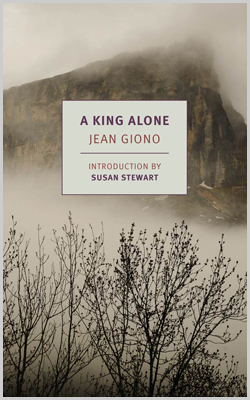Celia recommends A King Alone by Jean Giono:
 I slid into this novel first through its language. So: “Everything piles up on us; nothing moves. Green at first, the light turns the color of hare innards, then an extraordinary black that, black as it is, has shadows of deep purple.” Or else: “How can such perfection not have a consciousness, when all it takes is a puff of wind, an unfortunate shift of evening light, an odd tilt to its leaves for its beauty, defeated, to lose all its power to awe?”
I slid into this novel first through its language. So: “Everything piles up on us; nothing moves. Green at first, the light turns the color of hare innards, then an extraordinary black that, black as it is, has shadows of deep purple.” Or else: “How can such perfection not have a consciousness, when all it takes is a puff of wind, an unfortunate shift of evening light, an odd tilt to its leaves for its beauty, defeated, to lose all its power to awe?”
Like much of Jean Giono’s other work, A King Alone takes place in an isolated community, both embraced and menaced by the natural world. There’s a beech tree in the mountains, a remote village, an unnamed Monsieur V. whose descendant once read Nerval while sitting under the hollyhocks of his mother’s farm, long after the events with which the novel deals were over, a “big illustrated book about Cartouche and Mandrin and werewolves with their different snouts all portrayed in it”—a jumble of innocent-sounding commonplace details, in other words, that, over the course of the novel, become less innocent and more and more sinister. There’s a formal severity to Giono’s chatty narrator, with his encyclopedic knowledge of the villages around him. He sees everything—or, if he doesn’t see it, he’s heard of it. But the reasons for things, the interior lives of those he watches, are often beyond him. The mystery, in this novel, is never what has happened, but rather why.
So, here is the what: it is 1843, and the people of a small mountain village have begun to disappear. One young woman vanishes into the fog and is never seen again. A second man is gripped from behind and nearly carried off, a scarf wrapped over his head. He gets free but never sees his assailant. A seasoned hunter disappears, leaving his breakfast cold on the table. All that’s found is blood on the snow—and, at one point, a pig is attacked with a razor, leaving it covered in cuts that “looked like the alphabet of some unknown, barbaric language.” Some villagers catch sight of the murderer, but he’s elusive. They see him from behind or in the dark or disappearing into fog, and for a while it seems that he’s the devil himself, or a spirit of bloody nature, a werewolf (remember those snouts in the novel’s opening!), a creature that rejects human sensibility.
Summoned to deal with this scourge is Inspector Langlois, but only after a year has passed. The beast takes people in winter, when the mountain roads are hardest and most dangerous to travel. In spring, the villagers enjoy an illusion of safety. Langlois arrives in the winter of 1844. He will not solve the mystery until the next year, long after the moment when he feels that he has most completely failed. And what is this solution, exactly? A name. A house. A human. Not an explanation for why what happened has happened, but a moment of convulsive violence, without apparent cause.
The true story happens on the fringes of the narrative, in the moments of calm that occur in the interval before death and blood. When a man named Frederic walks out in the morning mist, and witnesses yet another murder, the conflict that ensues is not one of strength or wits, but simply with his own endurance and memory. Will he be brave enough to follow the man to his destination? Will he trust his own memory of what he saw?
Then there is the innkeeper the villagers call Sausage, a former prostitute who strikes up a friendship with Langlois and who remains the best, although reluctant, historian of his time in the village. She’s a liminal character who, by the novel’s end, I thought had become its heart. In the beginning, the villagers know her only as the fat woman with whiskers and a checkered past who runs the inn, and slowly we see her revealed, in a way that few characters in this novel are. She attends a wolf hunt, in which the villagers, under Langlois’s supervision, band together to drive out a creature that might almost be the desperate reincarnation of their phantasmal killer. She helps Langlois find a wife. And she blames herself because, despite her friendship, she ultimately can’t save him.
What people need saving from, in this mystery, is not the murderer under the bed or the wolf at the window, but rather the unknown interior of things—the question, that is, of how to go on in a world that defies explanation.
